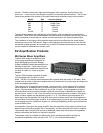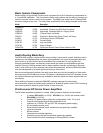
Step 4 – Assemble the Equipment List
At this point an equipment list needs to be assembled and the hardware portion of the job can be
estimated. Also labor estimates can be done as well after a site inspection has been conducted
and physical layouts to scale have been constructed.
Upon completion of a thorough site survey, the system may be specified and quoted. The sales
engineer may also generate the design and quote, often at the same time as the site survey.
Success at this stage depends upon experience and product knowledge.
To avoid ambiguity and confusion at the installation stage, the specifications need to be as
explicit as possible. Of course, it should enumerate all of the equipment proposed to do the job,
and should include both a block diagram and an accurate floor plan with annotations regarding
construction. In addition, it should provide details such as local volume control locations and
height, the desired location for amp racks, and even names of the employees who are expected
to use the system. To forestall disputes and clarify responsibility if changes are required during or
after installation, the customer should be asked to sign a written agreement governing the
specification.
Many contracting companies simply communicate the sales engineer’s design directly to their
installation department, who are charged with putting the system in and making it work. There are
potential problems with this approach. For example, the salesman’s natural tendency is to over-
design and oversell when he can; if the client is amenable, the result can be an excessively
complicated (and problematic) system. Moreover, it is easy to make mistakes in the flush of a
sale, and these may be compounded when the system goes in.
To address such pitfalls, it makes good sense to have each proposal reviewed by a second
engineering employee whose approval should be required before the specification goes to
installation. At this stage, design details can be fine-tuned and potential problems can be
addressed to assure that the design is feasible, efficient and free of unnecessary redundancy.
Expect The Unexpected
The distributed sound system market is highly competitive and margins are small. It makes good
sense to do everything you can to avoid problems at the installation stage and to be ready to
handle callbacks or last minute changes smoothly. One way to do this is to anticipate problems
before they occur and build contingency plans into your operation.
For example you should always have some inexpensive “fixes” at the ready. Say that the
customer decides to change his floor plan at the last minute, requiring you to add another zone to
the system. You can offer an additional MA series shelf-mount mixer/amplifier that enables you to
offer a painless quote for the requested change, and come out a hero. You can even avoid the
additional cost of installing a volume control in the new zone by putting the amplifier on a shelf in
the zone.
Similarly, it may make sense to pull a couple of extra cable pairs (both speaker lines and mike
lines) when making your home runs. That way, if there’s a base that wasn’t covered in the
specification, you can make it up onsite. The practice also facilitates expanding the system at a
later date.
Be sure that the floor plans you use are up-to-date, and keep communications open with the
client. Particularly if you are limited to using existing wiring, you need to know if the client’s plans
for space usage will remain the same. Otherwise, you may end up with a real headache — like
having the emergency room announcements directed to the pediatric ward
Finally, it is vitally important to be sure that you know who in the client’s company is authorized to
make decisions when questions arise on the job site. If the building manager tells your installers
to put the amp racks in the basement you don’t want the owners calling you and insisting that
they should have been in the second floor office
ElectroVoice/Dynacord BGM Guide Page 16


















